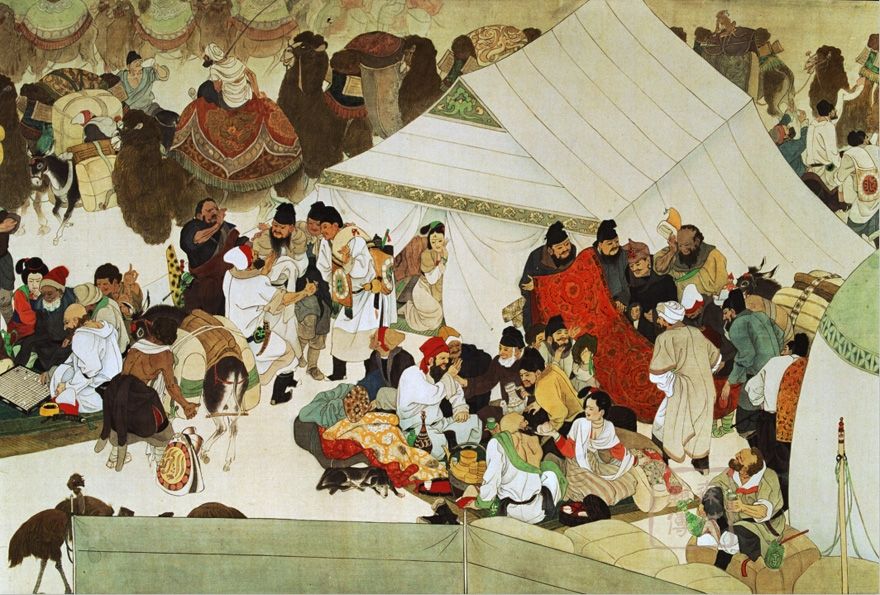History of art on Silk Road revealed by cultural exchange

The Silk Road has significantly promoted the artistic communications on clothes, procelain, architecture, music and dance between the countries along the route, serving as a bridge for cultural exchanges between the East and the West.
The Silk Road, a trade route that connected China and various Asian and European countries, also serviced as a bridge for cultural exchanges between the East and the West. The history of the Silk Road is nothing less than a condensed history of world civilization, a book of art history of the ancient world, and a treasure of human civilization.
Aesthetic evolution
Silk, as the name of the road indicates, was the most important commodity along the trade route. Raw materials, textiles and silk clothes, along with skills, arts and the culture of silk production were disseminated around the world via the Silk Road, promoting exchanges and interactions that aided in the cross-cultural development of textile production.
Liu Yu, a professor from the College of Fashion and Design at Donghua University, said a colored mural displayed in the Samarkand Museum of History in Uzbekistan depicts envoys of the Tang Dynasty (618-907) meeting the king of Sogdia, bearing silkworm cocoons, raw silk and white silk at a royal banquet. The mural shows that silk and the skills for its production were spread to Central Asia around the time of the Tang Dynasty.
Textiles are the most common type of product that reflected the integration of lifestyles of different peoples in regions and countries along the route. Liu said compared with other artistic genres, clothes are more frequently used, practical, popular, exhibitive, demonstrative and easily spread. They are a common symbol to illustrate the impact of the Silk Road on the progress of human civilization via daily clothing items and textile arts.
Convergence vs. clashes
Exchanges and integration of different forms of music and dances along the Silk Road also exerted profound and extensive impacts. Mao Hui, a research fellow at the Research Institute of Dance of Chinese National Academy of Arts, said the Book of the Later Han recorded many types of fashion and artistic genres in the Western Regions favored by Liu Hong, the Emperor of Ling of Han (c.156-189). During Emperor of Wu of Han, Liu Che’s reign (156 BCE-87 CE) envoy Zhang Qian was assigned to go on a mission to the Western Regions and brought back the song Mahadur, based on which court musician Li Yannian created another 28 pieces of music. Later, new instruments such as the pipa, hudi and konghou were introduced into Central China. Such exchanges of music and dance were gradually deepened in the following dynasties up until a peak in the Tang Dynasty. Mao said the Silk Road played an essential role in the formation, extension and development of music and dances in Chinese medieval history (221 BCE-1840).
Religion is another indispensable part of the cultural and artistic exchanges along the Silk Road. Li Yong, a professor from the College of Fine Art at Xinjiang Normal University, said the most typical example of this can be seen in the Kizil Grottoes, which formed a communication hub and absorbed cultural influences of foreign countries, such as India and Greece. This resulted in the creation of Buddhist art with distinct ethnic characteristics.
Li also suggested that the introduction of Buddhist art led to diversity and stylization of religious art along the Silk Road. Gandhara Art was also disseminated from Central to East Asia. The artistic skills involved in this art form originated from ancient Greece and the Roman Empire, including architectural styles, color matching and decorative painting. These were widely applied to Buddhist temples, grottoes and pagodas. At the same time, repeatedly coming into contact with Chinese culture, Western artists unconsciously absorbed Eastern elements.
Diverse expression
Lin Shaoxiong, a professor from Shanghai Film Academy at Shanghai University, said that the pottery in the Paleolithic age and the later porcelain art both constitute one big part of the Silk Road’s culture. These pottery and porcelain items had a profound impact on people’s daily habits, ideology and world civilization. For instance, the decorative figures on Chinese painted pottery were the result of systematic knowledge and practices, such as the method known as “lining figures,” which shaped Chinese artistic genes and culture.
Lin pointed out that as one of the earliest cultural creations, pottery not only shaped people’s way of life all over the world, but also laid a foundation for the fabric of human civilization and artistic way of thinking. Porcelain disseminated along the Silk Road since the Tang Dynasty, such as the celadon produced in the Yue Kiln, white porcelain in Xing kiln, and the Jingdezhen blue and white porcelain, influenced people’s way of life and aesthetic views in Southeast Asia, Central Asia, West Asia, Europe and Oceania.
Cheng Jincheng, a professor of literature from Lanzhou University, said that the core research on artistic exchanges between China and foreign countries along the Silk Road does not lie in a simple summary of established artistic phenomena and creations, nor is it merely a classification of different artistic genres, but rather, it consists of discussion on the artistic creations and meanings that emerged with the Silk Road.
